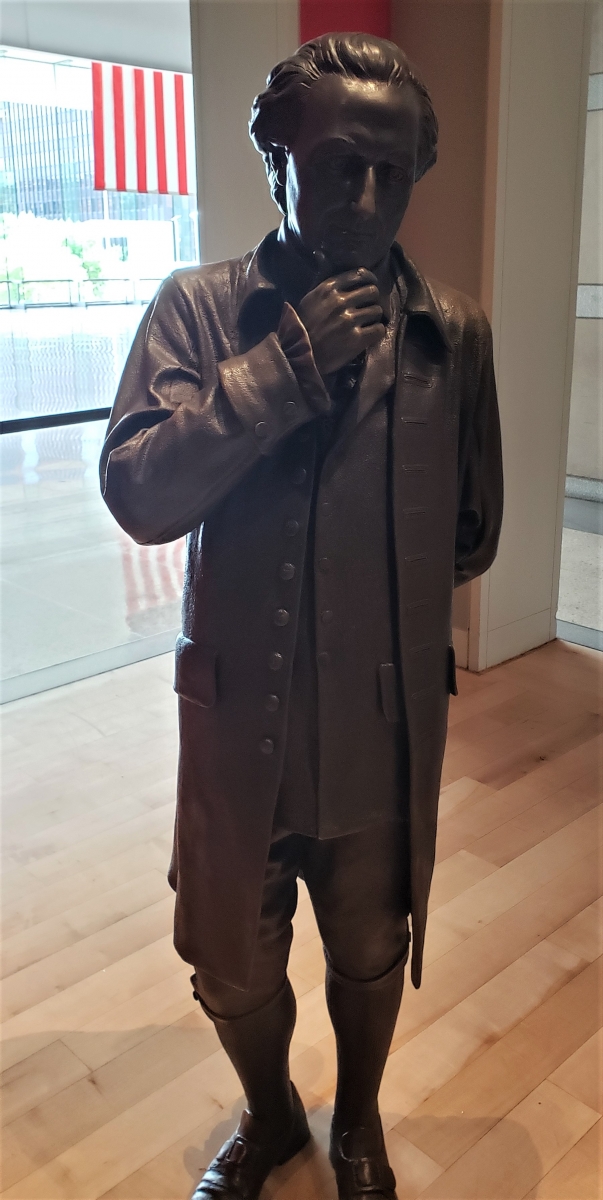Related Posts
- Buy Tickets for The Constitutional Walking Tour of Philadelphia – See 20+ Sites on a Primary Overview of Independence Park, including the Liberty Bell and Independence Hall
- Constitutional Convention
- Independence Hall
- Signers' Garden
- National Constitution Center
- First Continental Congress
- Carpenters' Hall
- Second Continental Congress
Birth: November of 1730 (exact date unknown)
Death: February 14, 1808 (age 75)
Colony: Delaware
Occupation: Lawyer, Plantation Owner, Soldier, Politician
Significance: Signed the United States Constitution (at the age of 56); served as President of Delaware from (1781 to 1783); and served as President of Pennsylvania from (1782 to 1785)

John Dickinson was born in Maryland to a prominent Quaker family on his family's tobacco plantation. Dickinson moved to Philadelphia at the age of 18, and he began studying law, eventually traveling to London where he studied at the Middle Temple. In 1757, Dickinson moved back to Philadelphia and began practicing law. Dickinson became politically active and in 1767, he began publishing a serious of essays known today as "Letters from a Farmer in Pennsylvania" in which Dickinson argued for the sovereign rights of the American Colonies. In 1774, Dickinson was appointed to the First Continental Congress and a year later he was also appointed to the Second Continental Congress, each time representing Pennsylvania.
When the time came for the Second Continental Congress to declare Independence, Dickinson was against Independence primarily due to his Quaker beliefs in non-violence. Dickinson did not sign The Declaration of Independence, and he decided to leave the Continental Congress and join the Pennsylvania Militia at this time. Even though his views on non-violence made him uncomfortable with declaring Independence, with the choice out of his hands and violence almost assured, he felt it was his duty to help the American cause. Within the Pennsylvania Militia, Dickinson rose to the rank of Brigadier General, but he struggled to live down his refusal to vote for Independence and was regularly passed by for promotions.
Dickinson resigned from his post in late 1776, and he moved to Delaware where the Delaware Government tried to appoint him to the Continental Congress, but Dickinson turned down the position. During the Revolutionary War, Dickinson became Delaware's wealthiest plantation owner and largest slaveholder. In 1777, however, he came to the belief that slavery was against his Quaker religion, and he began the process of freeing all of his slaves. In 1779, Dickinson finally returned to the Continental Congress, where he helped to write the earliest drafts and signed of the Articles of Confederation.
In 1781, Dickinson was named President of Delaware (the pre-Constitution equivalent to Governor). In an odd situation, he was also elected the President of Pennsylvania (the pre-Constitution equivalent to Governor) in 1782. Dickinson took on the role of President of Pennsylvania, but he did not immediately resign from his post in Delaware so he was the President of both states at the same time before he resigned from the Delaware office 1783.
After his term as President of Pennsylvania ended in 1785, Dickinson returned to Philadelphia where he was named as a member of the Constitutional Convention which met in Philadelphia in the Summer of 1787. At the Constitutional Convention, Dickinson represented Delaware, and he served as a strongest voice against slavery at the Convention and an advocate for the rights of small states.Dickinson helped to debate, draft and sign the United States Constitution.
After the Constitutional Convention, Dickinson remained involved in the abolitionist movement in Delaware and served within the state government before failing health forced his retirement. Dickinson died in 1808 at the age of 75.
John Dickinson in Philadelphia
John Dickinson ended up living in Philadelphia for many years during his life. Dickinson lived in Philadelphia while he was a member of the First Continental Congress, which met at Carpenter's Hall. Dickinson again lived in Philadelphia while he was a member of the Second Continental Congress in 1783. While a member of the Continental Congress, Dickinson worked at Independence Hall. Dickinson once again worked in Independence Hall when he helped to write the Constitution of the United States as a member of the Constitutional Convention in 1787. While working on the Constitution, Read stayed in a boarding house operated by Mrs. Mary House, located at the corner of 5th and Market Streets. Dickinson shared a room with fellow delegate George Read due to a shortage of available rooms.
Today, you can also see a statue commemorating Dickinson for his role in the creation of the United States Constitution in the Signers' Hall exhibit of the National Constitution Center. Signers' Garden pays tribute to the Founding Fathers, including those such as Dickinson who signed the Constitution of the United States. The National Constitution Center, Independence Hall and Signers' Garden are stops visited along The Constitutional Walking Tour!



